Freight train derailed - floodwater washed out track ballast after heavy rain. TAIC identifies safety issues with: foul weather responsiveness nationwide; staff training to deal with foul weather; and knowledge of risks and hazards associated with waterways next to its railways. Three recommendations to KiwiRail.
Executive summary Tuhinga whakarāpopoto
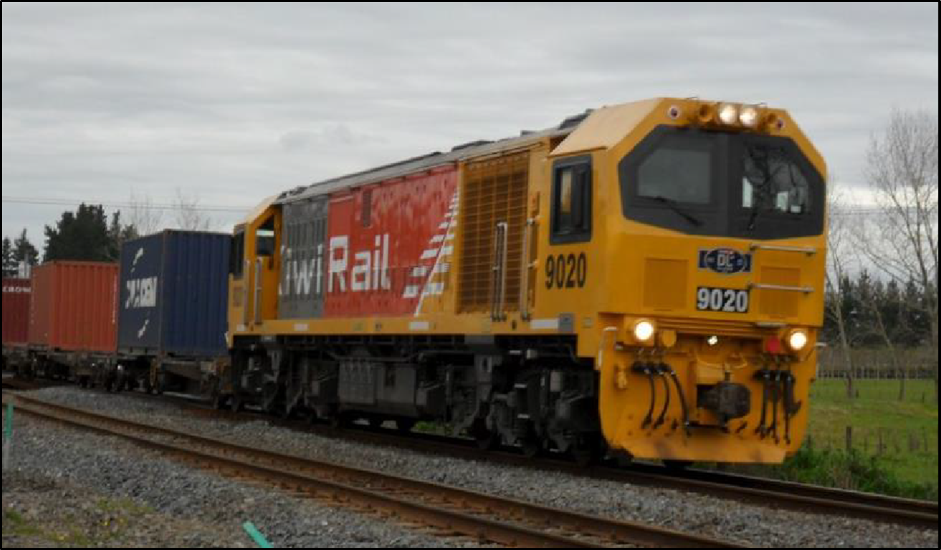
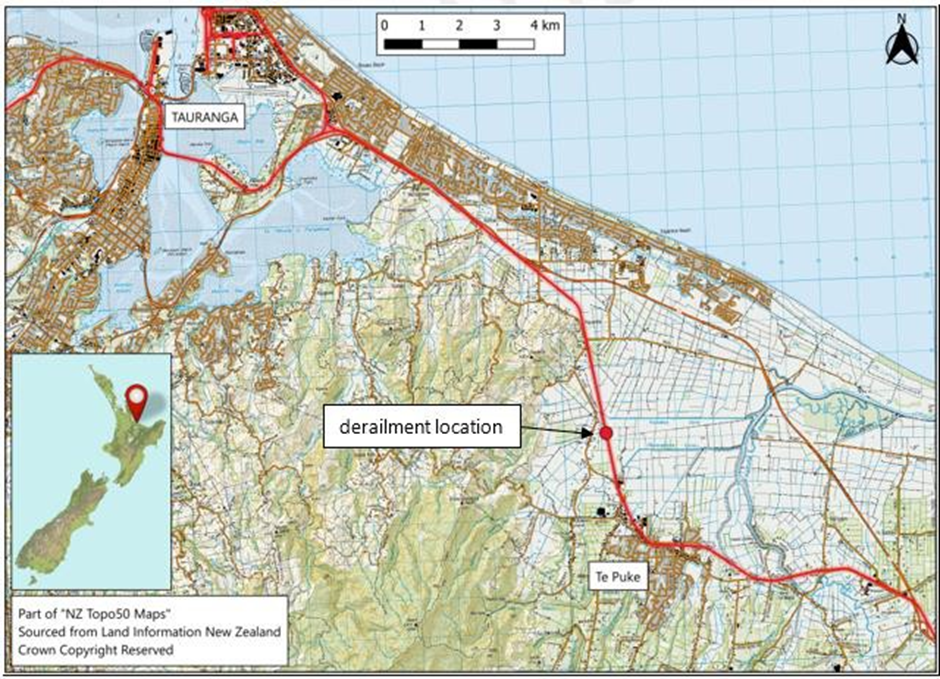
What happened
- On 27 and 28 January 2023, the Bay of Plenty region was experiencing heavy rainfall. On 28 January, the crew of a KiwiRail freight train (train 385) observed and reported to Train Control a high water level at rail bridge 85 on the East Coast Main Trunk (the rail line extended between Hamilton, Tauranga and Kawerau) line (ECMT) north of Te Puke.
- On receipt of the information, Train Control arranged for a track inspection to be conducted to assess the risks. The track inspection occurred at an incorrect location, resulting in clearance being given for trains to resume normal operations.
- At 0330 (times used in this report are expressed in the 24-hour format based on New Zealand Daylight Time) the next day, a KiwiRail freight train (train 360) conveying 39 wagons, with the same crew on board who had reported the high water the previous day, departed Kawerau rail terminal bound for Tauranga.
- At about 0430 the train, travelling at approximately 60 kilometres per hour, encountered substantial floodwater across the track north of Te Puke, not far from rail bridge 85. The crew felt the locomotive drop downwards before the emergency brake activated automatically, stopping the train approximately 150 metres past the floodwater.
- The crew disembarked to see what had activated the emergency brakes. They discovered that only the first five wagons were behind the locomotive, with the other 34 wagons missing. Of the five wagons behind the locomotive, four had uncoupled.
- It was later discovered that of those 34 wagons, 11 had derailed approximately 100 metres down the track.
- The crew reboarded the locomotive and contacted Train Control before moving the locomotive and the one remaining wagon forward to higher ground.
Why it happened
- The Bay of Plenty region had been experiencing heavy rainfall two days prior to the derailment. Rainfall that fell during that period overwhelmed rivers and waterways in and around Te Puke, including the drainage system along the rail corridor.
- At its peak, the water level around the accident site rose approximately 3.5 metres (this measurement was taken by Transport Accident Investigation Commission investigators during the site visit), causing scouring and washout of the rail track’s supporting formation.
- Without the supporting formation, the track was not able to support the weight of the train as it passed over the compromised section. This resulted in the decoupling and derailment of some of the wagons.
What we can learn
- As the frequency of severe weather events increases, risk assessments for transport infrastructure become more significant. Therefore, ensuring hazards are identified and appropriate controls are applied is essential.
- All personnel undertaking safety-critical roles should adhere to the principles underlying the application of non-technical skills to ensure that they share the same mental models and have a clear understanding of what is required of themselves and others to complete tasks safely.
- Engineering systems and real-time monitoring can assist in providing accurate information with which personnel can make timely and informed decisions and ensure a safe transport system.
Who may benefit
- Rail personnel, transport operators, infrastructure designers, maintainers of the infrastructure and anyone involved in planning and responding to the impacts of weather events on transport networks may benefit from the findings.
Factual information Pārongo pono
Narrative
Severe weather warning
- On the morning of Thursday 26 January 2023, Meteorology Solutions Limited (MetSolutions) provided an escalated weather alert and MetService provided a severe weather alert by email to KiwiRail’s Network Control Manager (NCM).
-
MetService provided a severe weather warning for heavy rain and strong northeasterlies for parts of the upper North Island, including significant rainfall in western Bay of Plenty, where heavy rain warnings were in force. The heavy rain warning for the Bay of Plenty west of Whakatāne stated:
Valid: 24 hours from 4:00pm Fri 27 Jan to 4:00pm Sat 28 Jan
Forecast: Expect 100 to 140 mm [millimetres] of rain about the ranges, with 60 to 90 mm elsewhere. Peak rates of 10 to 20 mm/h [millimetres per hour] expected about the ranges from Friday evening through to around dawn Saturday.
Note, once the heavy rain eases, showers are expected through the rest of the weekend.
-
MetSolutions provided a summary of significant rain and wind impacts for Friday and Saturday, which included:
Heavy rain for BOP Sat [Bay of Plenty on Saturday] with event totals reaching 100+ mm, esp. west of Tauranga, and for the Tokoroa and Rotorua line areas. More rain for Sun [Sunday], but less intense.
-
MetSolutions also provided updated information on the risks for all areas in its Weather Risk Matrix (see Figure 3).
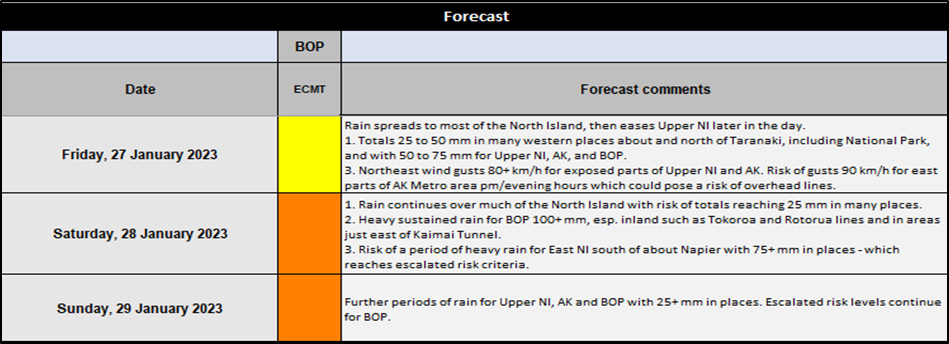
-
At 2034 on 26 January, MetService emailed an updated severe weather warning to the NCM. The expected volume of rain for the area of the Bay of Plenty west of Whakatāne was greater and over a longer period:
Valid: 30 hours from 12:00pm Fri 27 Jan to 6:00pm Sat 28 Jan
Forecast: Expect 120 to 160 mm of rain about the ranges, with 60 to 90 mm elsewhere. Peak rates of 10 to 20 mm/h expected about the ranges from Friday evening through to Saturday afternoon.
Note, the warning validity end time may be extended in the next issue.
-
At 0947 on 27 January, MetService provided a further updated severe weather warning to the NCM. The expected volume of rain for the area of the Bay of Plenty west of Whakatāne was even greater, with increased rates possible in thunderstorms, and for a longer period:
Valid: 33 hours from 10:00am Fri 27 Jan to 7:00pm Sat 28 Jan
Forecast: Expect 130 to 180 mm of rain about the ranges, and 70 to 110 mm elsewhere. Peak rates of 15 to 25 mm/h from this evening, especially about the ranges, however, rates of 25 to 35 mm/h are possible in thunderstorms.
- As the weather information was received by the NCM from MetSolutions and MetService, and in accordance with procedure, the NCM forwarded the information to all Field Production and Operation Managers around the country (see Appendix 1). The NCM did not alert the regional managers to the severe weather warnings.
- The Bay of Plenty Field Production Manager received the NCM’s emails and in response alerted the track inspectors to the forecast weather conditions for the upcoming weekend. They also contacted the Bay of Plenty Regional Field Production Manager to confirm receipt of the severe weather warning and to ensure that staff, contractors and provisions would be in place if required during the weekend period.
- On 27 January the Bay of Plenty region began experiencing heavy rain in what would evolve into a significant weather event due to a sub-tropical low pressure system that was moving across northern parts of New Zealand.
- Heavy rain continued to fall throughout 28 and 29 January. Train services on the East Coast Main Trunk (ECMT) continued to run to their normal schedules throughout this period.
Train crew observation and track inspection
- On 28 January at about 0630, the crew (the train crew comprised a trainee locomotive engineer (trainee) and a supervising locomotive engineer known as a minder. The crew was involved in the derailment on the following day) of train 385 (the crew) observed a significantly high water level as they crossed rail bridge 85 north of Te Puke (see Figure 4).
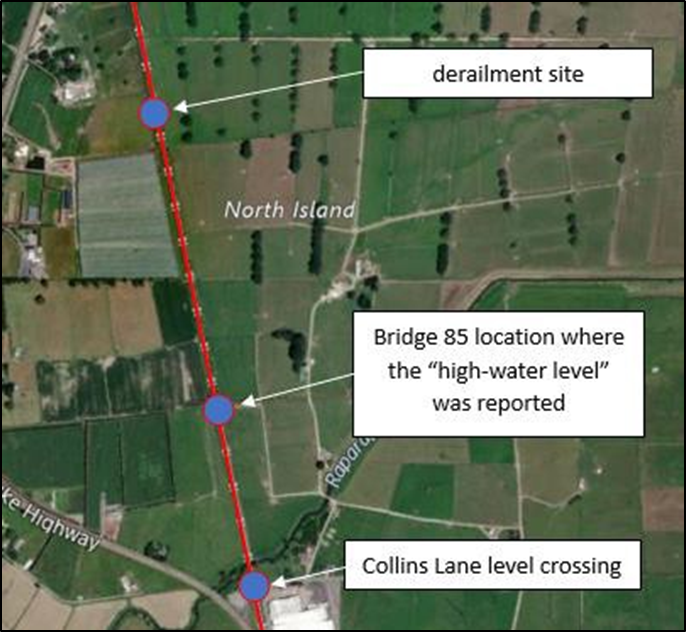
- Concerned, the crew radioed Train Control that the water level was getting up to the rail bridge, and other waterways in the area looked flooded. To confirm the location of the water, Train Control repeated back to the crew “east side of Te Puke”. The crew replied, “yer roger the Mount (the ‘Mount’ is a reference to Mount Maunganui (see Figure 5)) side of Te Puke are all getting high”. The Mount is to the west of Te Puke, not the east.
- Neither the crew nor Train Control included the track meterage or any track structures as reference points when communicating the location of the high water to assist in obtaining a common understanding of where the issue was located. Following the radio call from the crew, the Train Controller called the support desk (known as 155 operators) to request a track inspection.
- At about 0735, a 155 operator contacted a track inspector and informed them that “water was coming through the bridge east of Te Puke”. A track meterage of 119.190 kilometres (km) ECMT was given. This location was approximately 4 km south of the location of the high water levels observed and reported by the crew.
- At about 0815 the track inspector arrived at Collins Lane level crossing and called Train Control to gain authority to on-track and start the track inspection south to Pongakawa station (see Figures 4 and 5).

- At about 0905 the track inspector arrived at Pongakawa station, having completed the track inspection. They radioed Train Control and gave clearance to run trains at normal speeds, having found no visible track or infrastructure issues to report. The maximum line speed for the track was 70 kilometres per hour (km/h).
- From that time until the accident occurred, eight trains travelled along the ECMT and across bridge 85. None of the crew reported observing high water at any point along the route.
The accident event
- At about 0300 on 29 January, a trainee locomotive engineer (the trainee) and a locomotive engineer minder (the minder) arrived at Kawerau rail terminal to complete pre-departure paperwork. They were the same crew who had observed and reported on the high water level at bridge 85 on the previous day.
- They boarded the locomotive allocated for train 360 and carried out shunting movements to attach 39 freight wagons.
- At about 0325 train 360 departed Kawerau rail terminal on time and began travelling towards Tauranga in clear weather conditions.
- The one-hour journey from Kawerau to the south side of Te Puke was uneventful. Light rain had started falling as the train arrived at Te Puke.
- As the crew travelled over bridge 85, they noted that the water had subsided.
- At about 0432, while the train was travelling at 65 km/h, the trainee applied the brake to reduce the speed in preparation for a 40 km/h temporary speed restriction on the next rail bridge, approximately 1.5 km ahead.
- The train’s speed had reduced to 57 km/h when the trainee identified a large area of flooded farmland on the left-hand side of the track and alerted the minder.
- As the train’s headlights illuminated the track ahead, the crew observed water flowing over the track approximately 50 metres (m) ahead of the train.
- The minder then directed the trainee to “release the brakes and go' (this direction meant releasing the train’s brake application to the wagons and enabling the train to move forward to higher ground).
- The train entered the flooded section of track, and the crew felt the locomotive drop downwards, immediately followed by an application of the automatic emergency brake. The train came to a stop approximately 150 m further down the track.
- The activation of the emergency brake simultaneously sent an emergency call through the train’s radio system to Train Control. Train Control immediately contacted the crew, who reported that the train had lost air pressure, and they would investigate what had happened.
- The crew disembarked from the locomotive and began walking towards the rear of the train. When they arrived at the fifth wagon, they realised that they could not see the remaining 34 wagons. From their location, they could see that the track’s formation had washed down the embankment (see Figure 6).
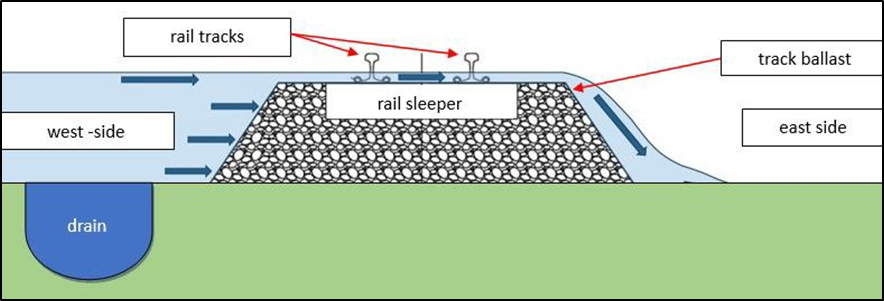
- On inspection, the crew found that four of the five wagons remaining with the locomotive had decoupled (see Figure 7), leaving only one wagon still connected to the locomotive. The crew then returned to the cab of the locomotive.
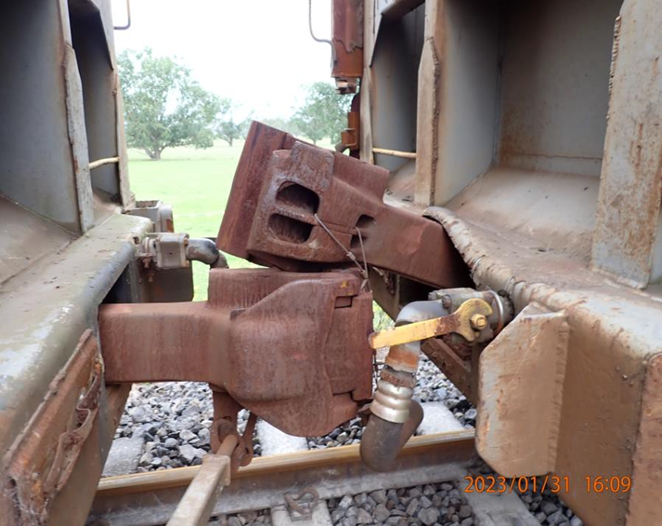
- The minder radioed Train Control and informed them that the rear 34 wagons were missing and that they needed to move because of unstable track formation and flooding at their current location.
- At about 0448 the crew moved the remaining connected wagon and the locomotive forward approximately 500 m north and waited for assistance.
- At about 0615 KiwiRail staff arrived at the site and carried out an inspection of the front and rear portions of the train. The inspection revealed that 11 of the 39 wagons had derailed and a large portion of the track had been damaged.
- The track was closed for 20 days to allow for repairs to be completed and the recovery of the train’s wreckage.
Personnel information
- The trainee had approximately 150 hours’ driving experience and had been employed by KiwiRail since 2021. They had completed their theory-based training and were undergoing the practical driving on-job training to become a fully certified locomotive engineer. They had recently undergone a safety observation assessment as part of their training requirement to complete 150 driving hours.
- The minder had 10 years’ driving experience and had been employed by KiwiRail since 2013. They had recently undergone a safety observation and were fully certified for the role.
- Both crew underwent drug and alcohol testing after the accident. Both tests indicated negative (clear) results.
Train information
- Train 360 was 592 m long and weighed 1785 tonnes. It was powered by a DL class diesel electric locomotive and hauling 39 wagons. The first nine wagons were carrying paper pulp, and the remainder were loaded log wagons.
Meteorological information
- The Bay of Plenty region had experienced heavy rainfall, a total volume of 131.8 mm in the two-day period prior to the train derailment (see Figure 8).
- The meteorological information received by KiwiRail is detailed in paragraphs 2.1 to 2.10.

Recorded data
- The locomotive was fitted with a Tranzlog data recorder. The Tranzlog download was obtained by the Transport Accident Investigation Commission (the Commission) and the verified data was used in this report (see Figure 9).
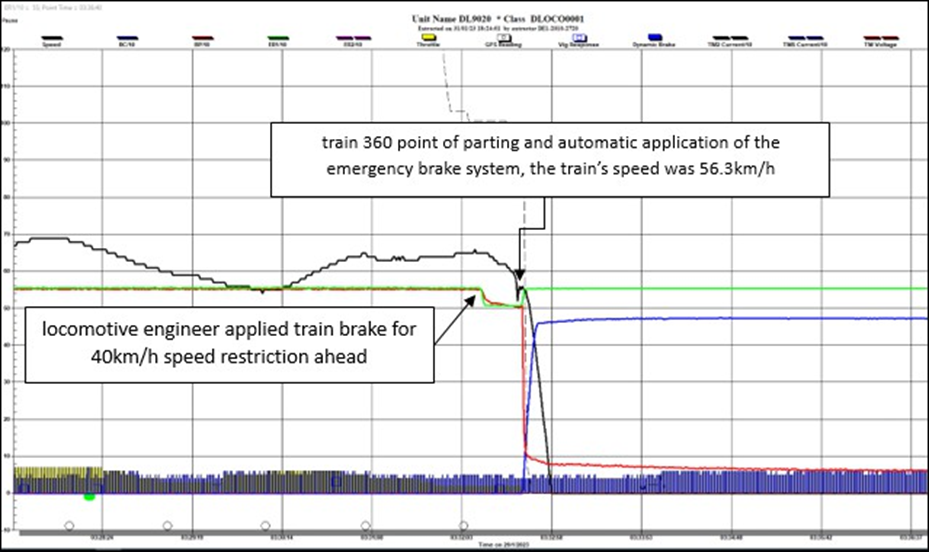
Site and wreckage information
- The accident site was at 115.715 km on the ECMT north of Te Puke. The track and infrastructure were maintained and inspected by KiwiRail. The derailment occurred on an elevated embankment that was between 2.4-3.5 m in height (this measurement was taken by Transport Accident Investigation Commission investigators during the site visit) with farmland on either side (see Figures 10 and 11).

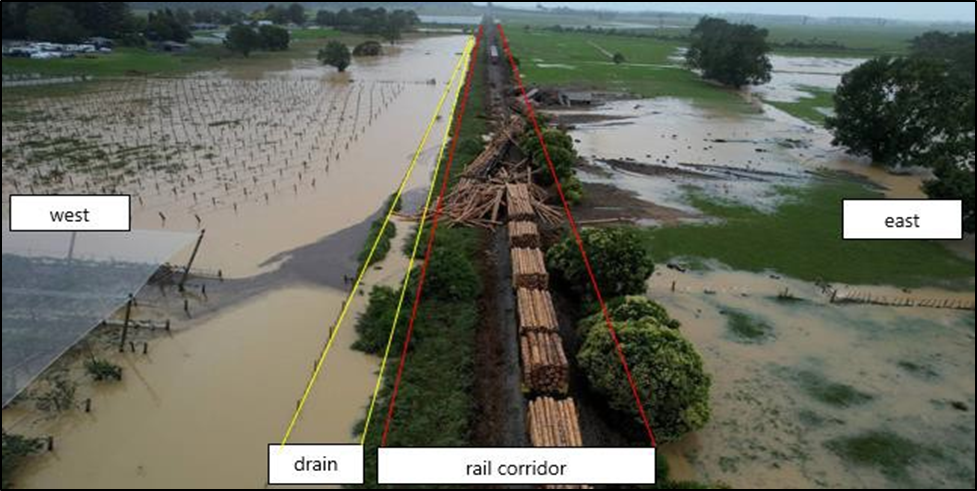
- Running adjacent to the west of the rail corridor was a drainage system. The drainage system was owned and maintained by the Bay of Plenty Regional Council.
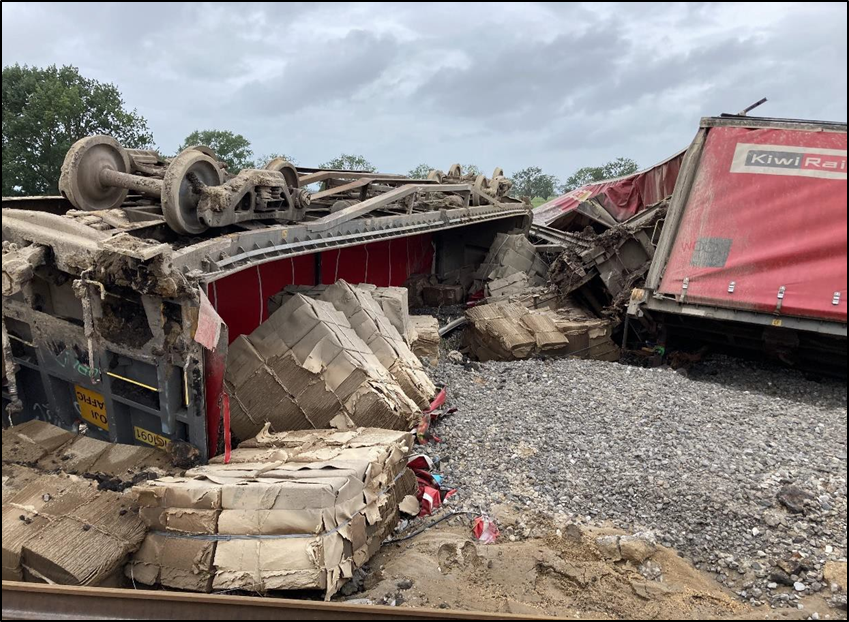
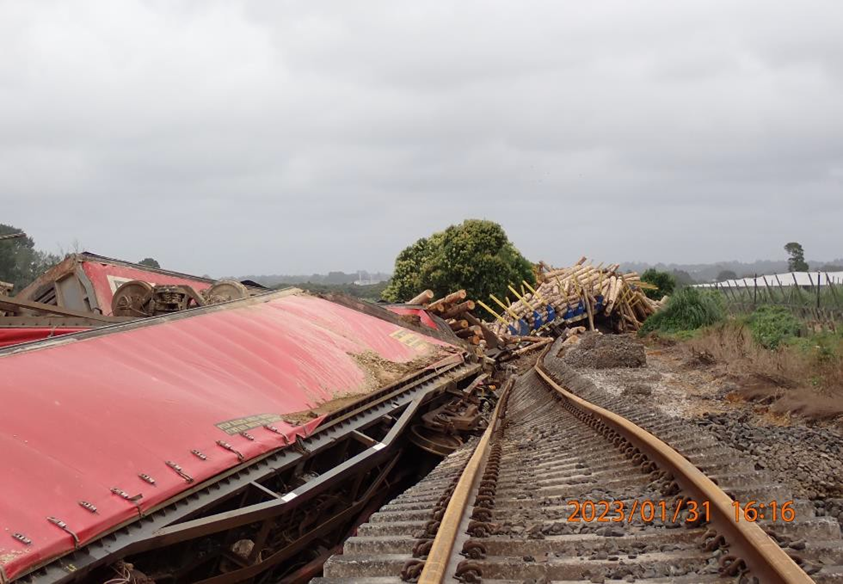
Organisational information
- KiwiRail Holdings Limited (KiwiRail) is a New Zealand state-owned enterprise. It operates trains and rail vehicles, controls rail movements on the national rail network and maintains the railway infrastructure as the rail access provider.
- The Bay of Plenty Regional Council maintains the Flaxton and Collins drains as part of the Kaituna river catchment scheme.
Previous inquiries
RO-2021-104 Passenger train 6205 derailment, Kāpiti, 17 August 2021
- On 17 August 2021, a Wellington-based passenger train was operating a scheduled service from Waikanae to Wellington on the North Island Main Trunk line (the portion of the rail network between Auckland and Wellington). The area had experienced moderate rainfall in the hills adjacent to the rail corridor, overwhelming the waterways and drainage systems that would normally have moved water away.
- The train rounded a right-hand curve next to the hillside, and the driver sighted a landslide covering both main lines in front of the train. The driver applied the emergency brake before the train hit the slip debris, derailing and losing all power. There were no injuries to crew or passengers.
RO-2021-106 Derailment of Train 220, south of Hunterville, 13 December 2021
- On 13 December 2021, an adverse weather event with heavy rainfall (greater than 10 mm up to 50 mm of rainfall in a 24-hour period, as outlined by the National Institute of Water and Atmospheric Research, Taihoro Nukurangi) resulted in streams and waterways being overwhelmed in the Hunterville area along the North Island Main Trunk line. The investigation found that floodwater had undermined the track formation, causing the derailment of a northbound freight train.
- The Commission identified the safety issue that there were no severe weather-warning or flood-monitoring measures in place in the accident area.
- KiwiRail undertook safety action to address this safety issue. That action included completing a hydrology assessment and flood modelling, planning the replacement of existing culverts with pipes, and planning the installation of a flood-monitoring system by April 2023.
- As a result of the safety action taken by KiwiRail, the Commission did not issue a recommendation.
ATSB (the Australian Transport Safety Bureau is Australia’s national transport safety investigator) Investigation RO-2021-004 Derailment of freight train 4BM4, Nana Glen, New South Wales, 25 February 2021
- On 25 February 2021, a southbound Pacific National freight train derailed near Nana Glen, New South Wales, Australia. Floodwaters had built up and overtopped the track, consequently washing away the ballast. The investigation found that the track manager had not adequately identified or addressed the risk of flooding along the rail corridor or the culvert near the accident site and had not undertaken formal assessments to determine the need for, or the locations of, remote weather-monitoring stations to detect extreme weather events.
- While some safety actions were taken following this accident, the ATSB issued a recommendation to develop guidance for crew to respond to and report extreme wet weather events or floodwater in the rail corridor.
Analysis Tātaritanga
Introduction
- On 29 January 2023, the derailment of freight train 360 occurred at Te Puke along the ECMT. There were no injuries or fatalities. The derailment caused significant damage to the rail wagons and the cargo being transported.
- The day before the derailment, a passing train crew had reported a higher-than-normal water level. As a result the track had been inspected, but at an incorrect location due to a misunderstanding of the location between the crew and Train Control.
- The investigation found safety issues in the following areas: KiwiRail’s adverse-weather procedures; the lack of emphasis in training on reporting unusual weather conditions; and oversight of the maintenance of waterways adjacent to the rail corridor.
- The following section analyses the circumstances surrounding the event to identify those factors that increased the likelihood of the event occurring or increased the severity of its outcome. It also examines any safety issues that have the potential to adversely affect future operations.
Adverse weather procedures
Safety issue 1: KiwiRail’s current response to adverse weather conditions is not fit for purpose and is not consistent throughout New Zealand’s rail network, increasing the risk of a rail accident occurring.
- Weather alert systems and robust procedures to respond to alerts are critical parts of operating a safe rail network. Well-known procedures and timely communication are crucial when a weather event is forming and occurring and after it passes, to ensure potential safety risks to the rail corridor can be monitored and responded to.
- KiwiRail receives weather information three times a week, and when escalating weather conditions are identified the updates are provided daily or twice daily, depending on the severity of the events.
- KiwiRail’s process at the time of the accident was to collate and distribute weather forecast information in emails. The information included the expected weather forecast and matrix table (the matrix table is used in conjunction with the weather forecast to outline potential risks to the rail network) thresholds for the following days.
- The weather information and the weather matrix table (the matrix table is used in conjunction with the weather forecast to outline potential risks to the rail network) are guides for the NCM and Field Production and Operations Managers to review and respond to if needed. The weather matrix table categorises expected weather conditions and their potential impacts on the rail network (see Figure 14) but does not include risk mitigations to ensure safe operation. Those are covered in KiwiRail’s Train Control Instructions (see Appendix 1) and Operating Rules (see Appendix 2).

- The weather matrix table comprises nine regions that cover the rail network throughout New Zealand (see Figure 15).
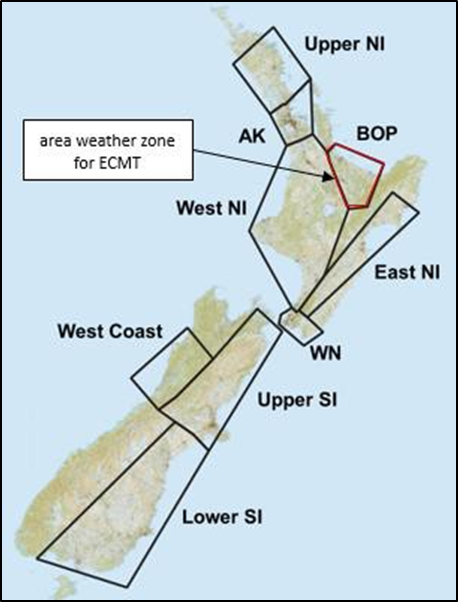
- The weather information received by KiwiRail between 27 and 29 January included a severe weather warning for the Bay of Plenty region. Yellow and amber warnings were given due to forecast rainfall (see Figure 16).
- The weather matrix table does not include mitigation measures appropriate for each warning level to ensure the safe operation of the rail network in those conditions. The process of assessing the response to a weather forecast of adverse conditions is completed by Field Production Managers and network managers as per KiwiRail’s Operating Rules.
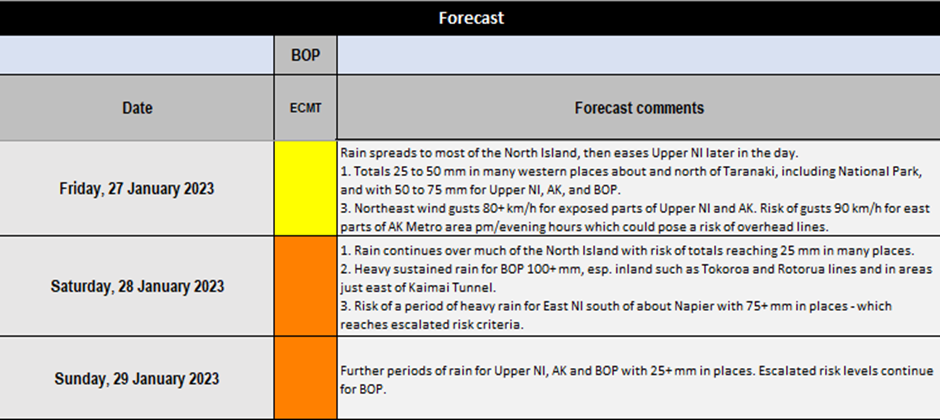
- The rail resilience map was designed to help with hazard assessments for civil works and the management of severe weather events (see Figure 17). The map colour-coded and ranked areas of the rail network that were subject to flooding, slope instability and scouring of bridge supports.
- The rail resilience map for the section of track between 115.00 km and 117.00 km ECMT and the surrounding land where the accident occurred was assessed as flood prone, with the risk of a flood ‘likely’, the consequences ‘major’ and the overall risk rating ‘very high’ (see Appendix 3). Neither the NCM nor the Field Production manager referred to the map after receiving the report of high water. If they had referred to the map, it is likely they would have identified that the area at which the crew reported high water was flood prone.
- The Bay of Plenty region Field Production Manager did not acknowledge (the acknowledgement process required the Field Production Manager to reply by email to the NCM, confirming they had received the weather information. If the information was not acknowledged, the NCM was required to escalate the information to the regional manager) receiving the weather-related information from the NCM and nor did the NCM escalate the information to the regional manager as required in the Operating Rules (see Appendix 1).
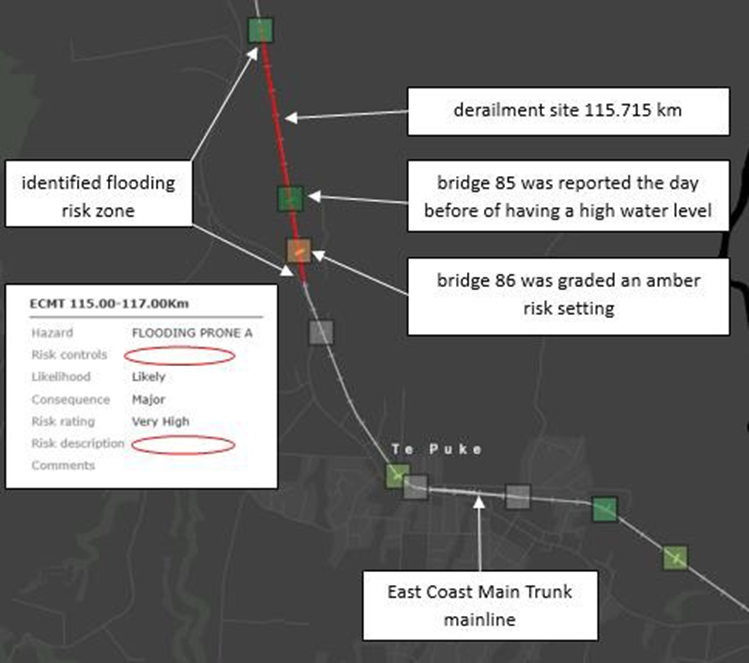
- In 2022, in response to a derailment, KiwiRail updated its Operating Rules to include mitigation measures for different levels of floodwater:

- The investigation found that, at the time of the accident, KiwiRail’s weather response guidance was not consistent across New Zealand’s rail network. For example, in the South Island the main North Line between Christchurch and Picton operated a weather Triggered Action Response Plan (TARP), which covered both rainfall forecast and antecedence rainfall levels.
- The TARP provided clear guidance on the appropriate mitigation measures at varying rainfall volumes (see Figure 18).
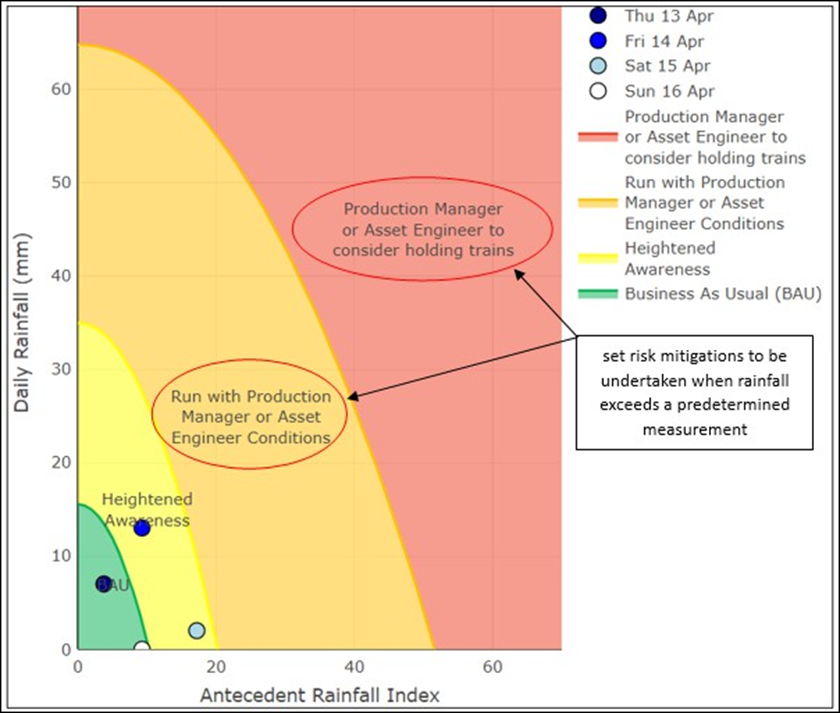
- Had there been a TARP in place in the Bay of Plenty region, it is likely the forecast rainfall would have triggered a heightened awareness and proactive rather than responsive track inspections and/or track closures.
Real-time weather-alert systems
- Real-time weather-alert systems are widely used in rail operations around the world and in some parts of New Zealand’s rail network. When correctly installed and located, they allow a high level of monitoring oversight across the network, alerting rail operators of changing and adverse conditions.
- KiwiRail has a number of heat and rainfall monitoring devices (see Figure 19) in place along the ECMT. The devices can be set to send alarms to Train Control when certain temperatures or rainfall volumes are reached.
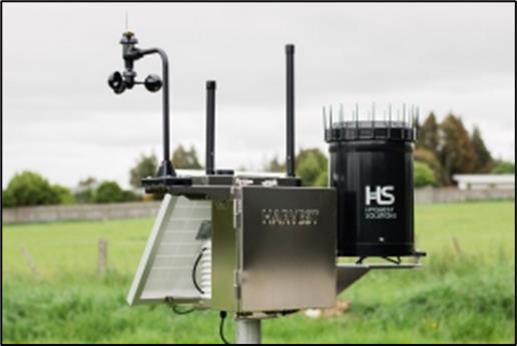
- The closest device was approximately 22 km from the accident site. The device was not set to send an alarm to Train Control but had live monitoring available through KiwiRail’s weather platform, Harvest.
- The device recorded 137 mm of rain in the 52-hour period between 27 to 29 January. The rainfall recorded exceeded the yellow and amber levels in the weather matrix table.
- The rainfall monitoring device nearest to the area reported as having high water was not accessed or monitored and the device had not been set to alert Train Control when rainfall levels exceeded the amber warning settings. It is likely that risk controls would have been put in place to avoid an accident if Train Control had received a warning or the live rainfall had been monitored. The monitoring equipment should have been utilised to its full extent.
Training in reporting unusual weather conditions
Safety issue 2: The training given to locomotive engineers and other rail personnel on the procedures for reporting and receiving unusual weather-condition information was inadequate. This meant the procedures to ensure the safe operation of trains were not initiated in accordance with KiwiRail’s Operating Rules (Section 1 – General Rules, rule 6(b)).
- Training in and the ability to apply theory-based rules are essential to ensure rail operators’ safety.
- The investigation found that the training provided for KiwiRail rail personnel did not emphasise the importance of knowing and understanding the rules for reporting and responding to unusual weather conditions. While the training included an examination, the different weather severity levels and corresponding risk controls were not included. The weather-related risks were not subject to ongoing safety observation assessments or included in rules-based revalidation programmes.
- Another aspect of the training was non-technical skills (NTS), including effective communication. Having the ability to communicate effectively is especially important when tasks are infrequent and individuals have differing mental models.
- NTS can be defined as the cognitive, social and personal resource skills that complement technical skills and contribute to safe and effective task performance. Sub-categories of NTS include situational awareness, communication, decision-making, leadership, teamwork, workload management and self-management.
- The effective use of NTS is an important defence in capturing and/or mitigating the effects of human error. It is even more important in systems that, in the absence of more robust engineering controls, are primarily reliant on individual performance and less-effective administrative controls.
- As part of their NTS training, Train Controllers are advised to proactively communicate certain intentions to field personnel to facilitate situational awareness and allow opportunities to detect and correct errors.
- The investigation found that when the crew reported a higher-than-normal water level to Train Control, critical information was not transferred between the parties (see Appendix 2). That information included the bridge number, the track meterage location and confirmation of a shared understanding. Instead, when Train Control sought confirmation of the location and asked, “east side of Te Puke?” the crew replied, “yer roger the Mount side of Te Puke are all getting high”.
- Train Control could not identify the precise location of the observed high water level, as the information provided by the crew was not detailed enough. This meant Train Control advised the service desk of an incorrect location for the observed high water level.
- The support desk informed the track inspector that the issue was water leaks from a bridge and the location was 119,190 km on the ECMT, which was approximately 4 km from the location of the observed high water level.
- Based on the information received, the track inspector started the inspection 2 km away from the observed high water level at bridge 85 and inspected an area in the opposite direction (see Figure 5).
- Had the crew provided and Train Control received and passed on the accurate location of the observed high water level, it is very likely the track inspector would have inspected the correct location and implemented appropriate risk mitigations in response to what they discovered.
Maintenance of waterways
Safety issue 3: KiwiRail did not have adequate awareness of the maintenance of third-party waterways within the rail corridor, including culverts. The insufficient maintenance of the waterways within the corridor increased the risk of the waterways not functioning as designed.
- Effective maintenance plans are a vital component of ensuring that infrastructure remains fit for purpose, particularly when it can be adversely affected by weather.
- The Bay of Plenty Regional Council owned the drainage system adjacent to the section of rail corridor where the accident occurred. The drainage system was part of the Kaituna river catchment control scheme, which included the Flaxton drain (1308 m long) and the Collins drain (442 m long). Both drains flowed into a canal system (see Figure 20).
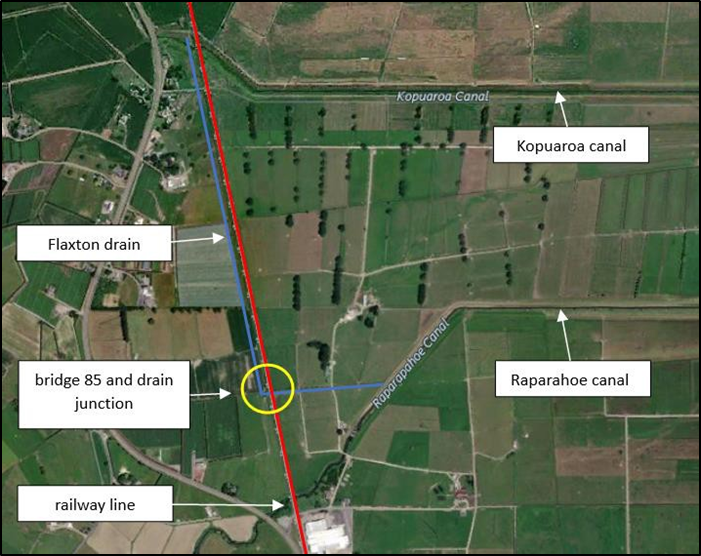
- Where the Flaxton drain and Collins drain intersected, the vegetation on both sides had grown down to the water level (see Figure 21).
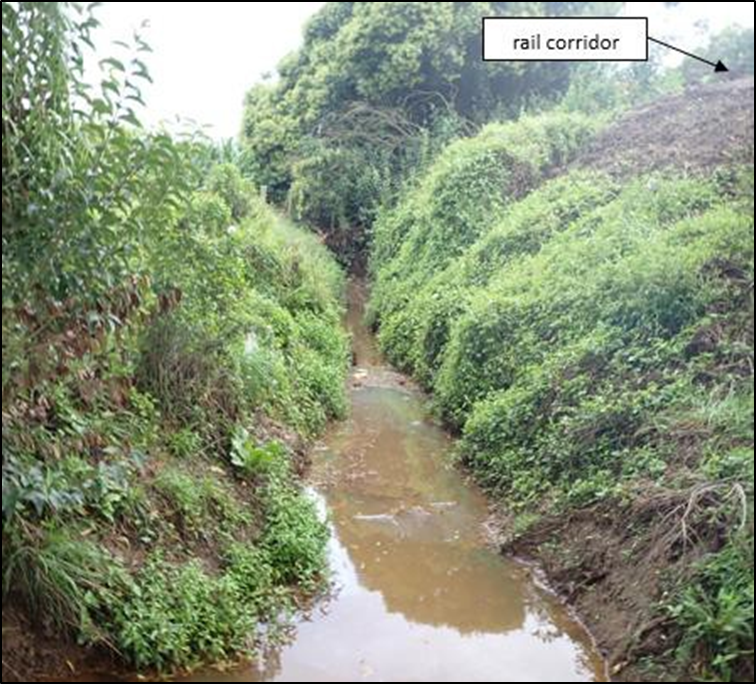
- Located approximately 60 m south of the accident site was a single, 750 mm diameter concrete culvert, owned and maintained by KiwiRail. The culvert allowed water to flow beneath the rail corridor and was approximately 0.5 m above the Flaxton drain. The purpose of the culvert was to move excess water from the farmland in the east to the Flaxton drain in the west. It was not designed for flood mitigation.
- However, when floodwaters breached the top of the Flaxton drain, the culvert allowed water to move from the drain east onto farmland (see Figure 22). Eventually the culvert was also overwhelmed by the volume of floodwater, resulting in the water crossing over the track, undermining the track formation and washing out the ballast.
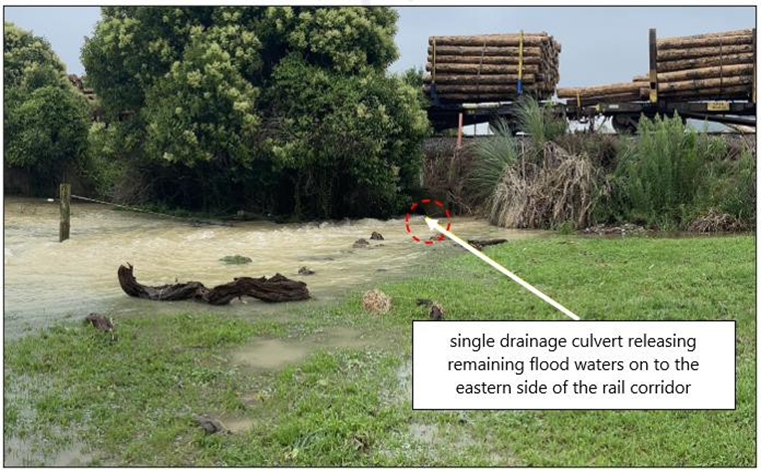
- The maximum capacity of the drainage system maintained by the Council was a daily rainfall of 37 mm for a maximum of three consecutive days, a one-in-five-year weather event. The heavy rainfall that fell during 27 and 28 January 2023 exceeded that capacity.
- When attending the accident site after the floodwater had subsided, the Commission investigators found the culvert was partially blocked on the western side by a vertically positioned wooden railway sleeper and that vegetation had grown into the area where the Flaxton drain met the culvert (see Figure 23).
- Subpart 1 of Part 3 of the Railways Act 2005 provides licensed access providers (being KiwiRail in this accident) with specific powers for the purpose of protecting the rail corridor. Section 74 addresses drains within the rail corridor and places the obligation to pay for the maintenance of drains on, above and under any railway infrastructure that is part of a sewerage or stormwater drainage system under the control of a road controlling authority or local authority, on that authority (Section 74(1), Railways Act 2005). In order to maintain the drain, the authority needs the prior consent of the licensed access provider, which may not be unreasonably withheld in an emergency.
- Section 77 of the Railways Act 2005 allows licensed access providers to, among other things, maintain and carry out protective work on the bank of a river or stream for the purpose of protecting the railway or preventing or lessening the risk of damage to railway infrastructure (Section 77(1), Railways Act 2005). A licensed access provider can also give notice to the occupier or owner of land abutting any railway structure to remove, lower or trim to the satisfaction of the licensed access provider any tree or hedge if the work is necessary to prevent damage to the railway infrastructure or obstruction to a channel, ditch or drain associated with that railway (Section 77(3)(a), Railways Act 2005).
- Had KiwiRail been aware of the vegetation growth in the drainage system adjacent to the rail corridor, it is likely KiwiRail would have requested Bay of Plenty Regional Council to carry out maintenance.
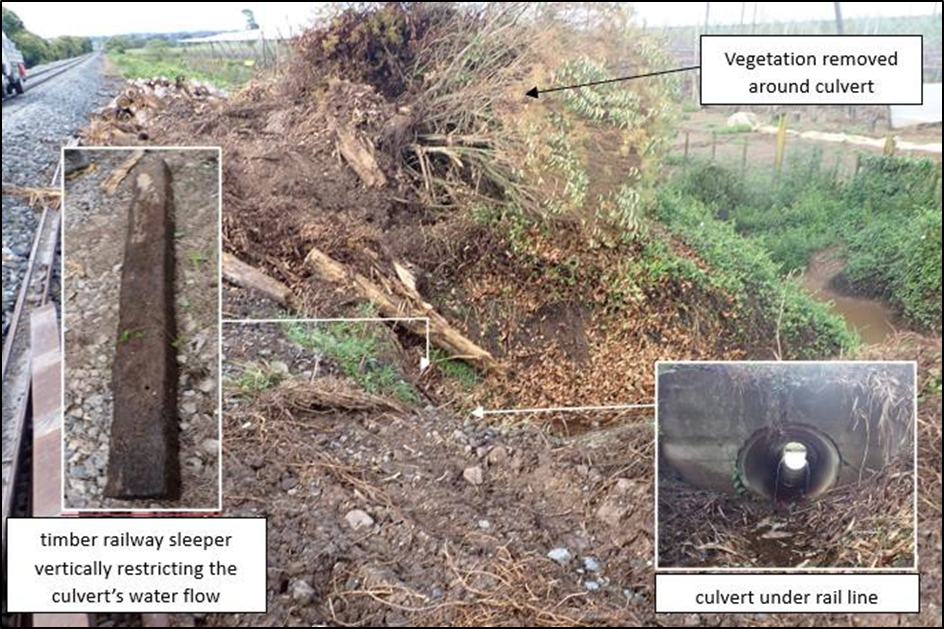
- Remedial works post the accident were completed by the Bay of Plenty Regional Council. This work included the removal of a culvert within Collins drain located near bridge 85, which was removed due to its being blocked with compacted soil. Upon its removal, a smaller pipe was found within the culvert. The culvert removal created an open drainage system up to and under bridge 85 (see Figure 24).
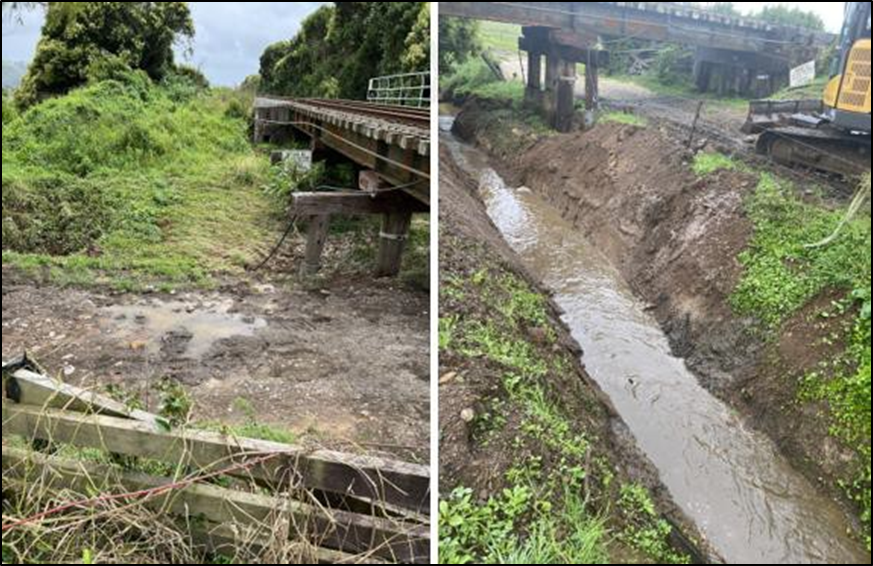
Findings Ngā kitenga
- KiwiRail’s Network Control Manager did not follow the operator’s procedures for adverse-weather-event. They forwarded a weather notification to all managers when they should have assessed the severity of the notification and the areas of the rail network that would likely be affected.
- Had the Network Control Manager and manager referred to the rail resilience map, it is likely they would have identified that the area where the crew reported high water was flood prone.
- Had there been a TARP in place for the Bay of Plenty region, it is likely the forecast rainfall would have triggered a heightened awareness, and KiwiRail would have carried out proactive rather than reactive track inspections and/or track closures.
- The rainfall monitoring device nearest to the area reported as having high water was not set to alert Train Control or the Network Control Manager when rainfall exceeded the amber warning settings. It is likely that risk controls would have been put in place to avoid an accident if Train Control or the Network Control Manager had received such a warning.
- Had the crew provided, and Train Control received and passed on, the accurate location of the observed high-water level, it is very likely the track inspector would have inspected the correct location and implemented appropriate risk mitigations in response to what they discovered.
- Had KiwiRail been aware of the vegetation growth in the drainage system adjacent to the rail corridor, it is likely it would have requested Bay of Plenty Regional Council to carry out maintenance.
Safety issues and remedial action Ngā take haumaru me ngā mahi whakatika
General
- Safety issues are an output from the Commission’s analysis. They may not always relate to factors directly contributing to the accident or incident. They typically describe a system problem that has the potential to adversely affect future transport safety.
- Safety issues may be addressed by safety actions taken by a participant; otherwise the Commission may issue recommendations to address the issues.
Safety issue 1: KiwiRail’s current response to adverse weather conditions is not fit for purpose and is not consistent throughout New Zealand’s rail network, increasing the risk of a rail accident occurring.
- In response to the accident, KiwiRail commenced a risk-based review of all its severe weather event management processes, controls and trigger action responses. The programme of work will look at existing systems, events and incidents, monitoring systems, lessons learned, gaps and concerns.
- KiwiRail is taking steps to introduce organisation-wide adverse weather event standards and processes. There will be a six-stage approach: Stage 1: Notification/Alert; Stage 2: Preliminary assessment; Stage 3: Conference call; Stage 4: TARP-based action plan; Stage 5: Monitoring; and Stage 6: De-escalation and close out.
- KiwiRail intends to have the adverse weather event standards and processes in place throughout New Zealand by the end of 2024.
- The Commission acknowledges KiwiRail is taking safety actions to address this safety issue. However, until the adverse weather event standards and processes are in place throughout the network, the safety issue will remain. Therefore the Commission has made a recommendation in Section 6 to address this issue.
Safety issue 2: The training given to locomotive engineers and other rail personnel on the procedures for reporting and receiving unusual weather-condition information was inadequate. This meant the procedures to ensure the safe operation of trains were not initiated in accordance with KiwiRail’s Operating Rules (Section 1 – General Rules, rule 6(b)).
- No action has been taken to address this safety issue. Therefore the Commission has made a recommendation in Section 6 to address this issue.
Safety issue 3: KiwiRail did not have adequate awareness of the maintenance of third-party waterways within the rail corridor, including culverts. The insufficient maintenance of the waterways within the corridor increased the risk of the waterways not functioning as designed.
- No action has been taken to address this safety issue. Therefore the Commission has made a recommendation in Section 6 to address this issue.
Recommendations Ngā tūtohutanga
General
- The Commission issues recommendations to address safety issues found in its investigations. Recommendations may be addressed to organisations or people and can relate to safety issues found within an organisation or within the wider transport system that have the potential to contribute to future transport accidents and incidents.
- In the interests of transport safety, it is important that recommendations are implemented without delay to help prevent similar accidents or incidents occurring in the future.
New recommendations
- On 24 April 2024 the Commission recommended that KiwiRail review its adverse weather response system and processes to ensure they are effective in maintaining a safe rail network. (012/24)
-
On 14 May 2024, KiwiRail replied:
This recommendation is accepted. We are developing the Adverse weather TARP and targeting completion of this rollout in 2024.
-
On 29 January 2025, KiwiRail replied:
KiwiRail review its adverse weather response system and processes to ensure they are effective in maintaining a safer rail network
KiwiRail Submission on Rec:
We are developing the Adverse weather TARP and targeting completion of this rollout in 2024.
This recommendation is implemented. What we are doing
An Enterprise Wide SHE Management Standard has been developed and published. This provides the mandatory processes and additional guidance information relating to Severe Weather Events. This document has been developed in conjunction with the Weather Risk Matrix Trigger Response Plan (TARP). These were published on 26 September 2024. Copies are attached.
Summary:
We are satisfied our actions have addressed this rec and this is now Business as usual activity
Therefore we are treating this recommendation as closed.
- On 24 April 2024 the Commission recommended that KiwiRail place greater emphasis on training rail personnel in reporting unusual weather conditions (in accordance with KiwiRail’s Operating Rules, Section 1 – General Rules, rule 6(b)), to ensure they retain currency. (013/24)
-
On 14 May 2024, KiwiRail replied:
This recommendation is rejected. KiwiRail’s view is that the training for rail personnel that is included in the RSR training component that relates to rule 6(b), is sufficient in so far as it is a low-level control for managing adverse weather. The complexity of weather events would also preclude any meaningful training as it would otherwise require a significant number of scenarios to be credible. Our Adverse weather TARP – see response to recommendation 012/24 – was developed in consideration of this position and rail personnel knowledge in the way we will manage adverse weather events going forward.
- On 24 April 2024 the Commission recommended that KiwiRail satisfy itself that all waterways within the rail corridor, including those owned by third parties, have effective and up-to-date maintenance programmes to ensure that the waterways can function as designed. (014/24).
-
On 14 May 2024, KiwiRail replied:
This recommendation is under consideration and will require further discussions with external parties.
-
On 1 April 2025 KiwiRail provided an update:
This recommendation is (Under consideration) What we are doing:
There are two parts to this recommendation
Our approach to the two parts have been different by necessity and achievability of the recommendation. The first part is managed through our regular meetings with the regions, inspection reviews and some pending new task instructions for corrective maintenance and inspections of drainage assets. We don;t have specific maintenance programmes for waterways, rather we are targeting standardised and cyclical maintenance for higher risk areas and assets and a pragmatic approach using standard maintenance approaches for wider network locations.
The second part of this recommendation will not be progressed. KiwiRail aren't responsible for maintenance of third-party assets as we do not hold records of assets we don’t own.
Summary:
We are satisfied our actions have addressed this rec and No further action required
Therefore we are treating this recommendation as closed.
Key lessons Ngā akoranga matua
- Accurately identifying and reporting risks that could affect the safety of the rail network is a vital layer of protection to ensure a safe rail operating system.
- It is important that rail personnel are appropriately trained to respond effectively to adverse weather and adverse track condition notifications.
- The maintenance of waterway systems is vital to ensure the system can work to its design specifications.
- As the frequency of adverse weather events increases, rail operators and those responsible for the infrastructure need to respond to future-proof the safety of rail operations.
Data summary Whakarāpopoto raraunga
Details
Conduct of the inquiry Te whakahaere I te pakirehua
- On 29 January 2023, Waka Kotahi notified the Commission of the occurrence. The Commission subsequently opened an inquiry under section 13(1) of the Transport Accident Investigation Commission Act 1990 and appointed an investigator in charge.
- Commission investigators attended the site on 30 January and conducted a site investigation.
- The Commission obtained records and information from sources that included:
- locomotive engineers and four KiwiRail rail personnel
- Tranzlog data from the locomotive
- Train Control voice recordings
- Train Control graphs
- meteorological data for the area
- rail formation specifications
- drainage and culvert specifications
- KiwiRail’s severe weather procedures.
- On 22 February 2024 the Commission approved a draft report for circulation to seven interested parties for their comment.
- Five interested parties provided detailed submissions, one interested party did not respond and one interested party replied that they had no comment. Any changes as a result of the submissions have been included in the final report.
- On 24 April 2024, the Commission approved the final report for publication.
Glossary Kuputaka
- Derailment
- An event that occurs when a rail vehicle’s wheels disengage their connection with the top of the rail head
- East Coast Main Trunk
- The railway network that runs from Hamilton to Tauranga and Kawerau and is connected to various other mainline rail networks, stations and rail sidings to operate trains and rail vehicles for the movements of commuter passengers and freight.
- Locomotive
- Self-propelled rail vehicle that provides motive power for a train
- Locomotive engineer
- Mainline train drivers are referred to by KiwiRail as locomotive engineers to reflect the required qualifications of the role.
- Network Control Manager
- The Network Control Manager is a shift-working manager based in the train control centre who is responsible for activity on the rail network throughout the country.
- Support desk
- The KiwiRail support desk takes incoming communications and network-related issues and organises staff to complete various maintenance tasks on and inspections of the rail network.
- Track formation
- The track formation is the supporting material used under and around rail sleepers; it supports the track and includes the lower supporting compacted materials used in construction.
- Track meterage
- Each rail line is identified by track meterage starting from a 0.000 km location and is set out in half-kilometer and full-kilometer sections until the end of the line. 17 A rail employee who controls rail vehicle movements.
- Train control
- The centre from where the movement of all rail vehicles and track access in a specified area are brought under the direction of a Train Controller
- Train controller
- A person qualified to authorise rail movements and track access. Train controllers operate in a train control centre.
- Trainee locomotive engineer
- A locomotive engineer undergoing on-job training prior to certification.
- Triggered Action Response Plan
- A plan used to give guidance on responding and acting or following tested procedures in an event
- Wagon
- A wagon is a rail vehicle that moves freight on the rail network.
Appendix 1. Train Control Instruction M007 -Severe Weather Advisory Management
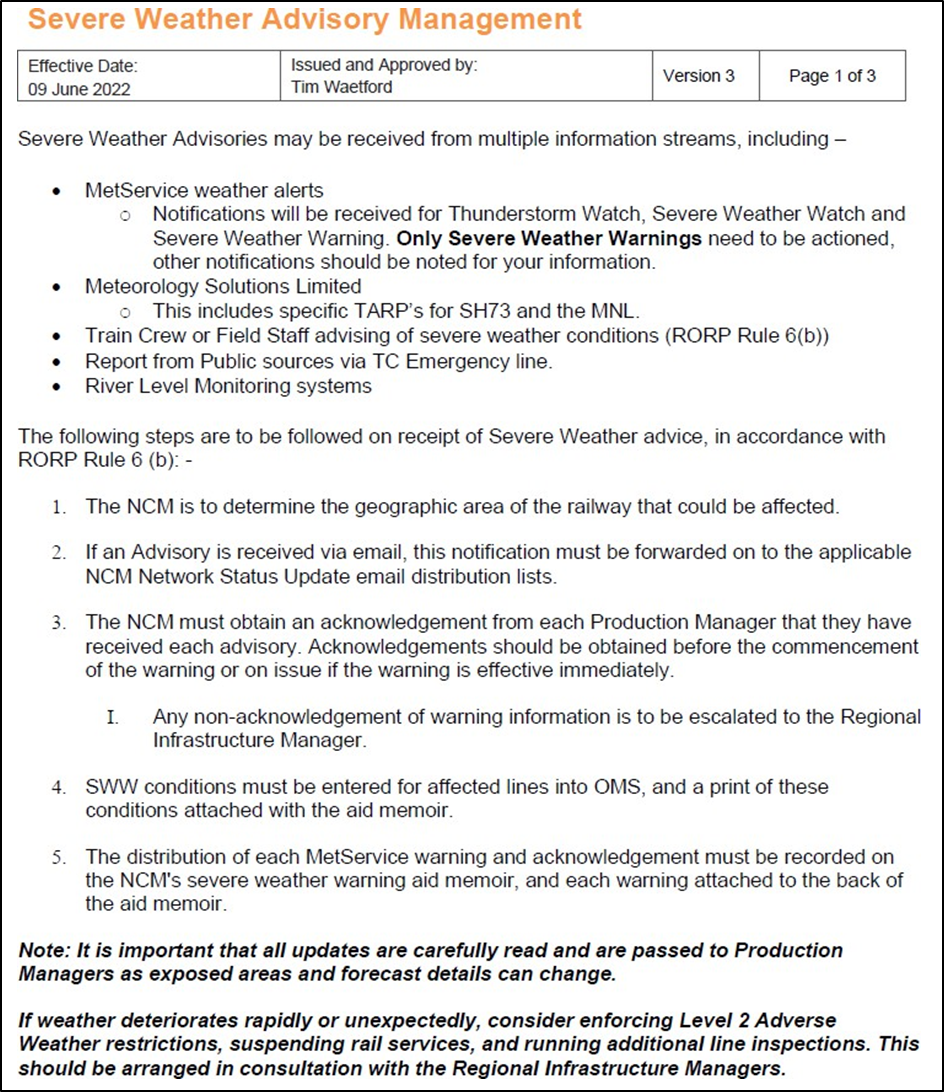
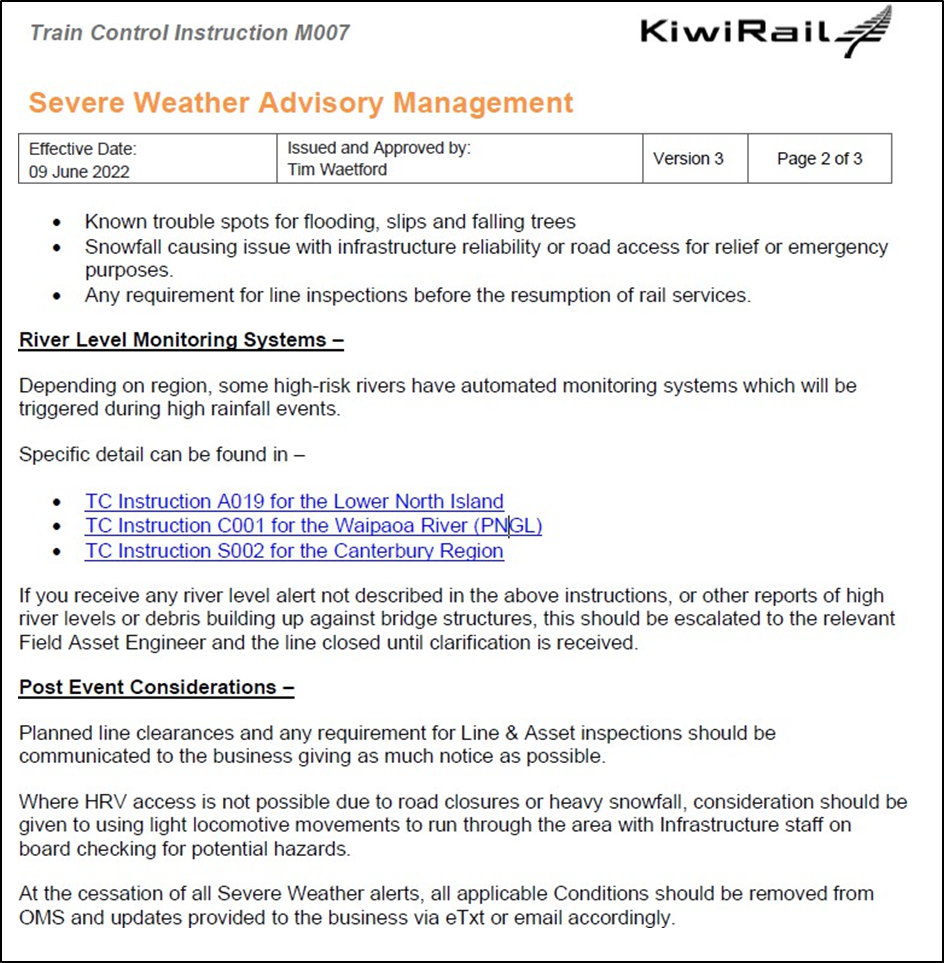
Appendix 2. KiwiRail Operating Rules, Section 1 – General Rules, Rule 6(b) Reporting Unusual Weather Conditions
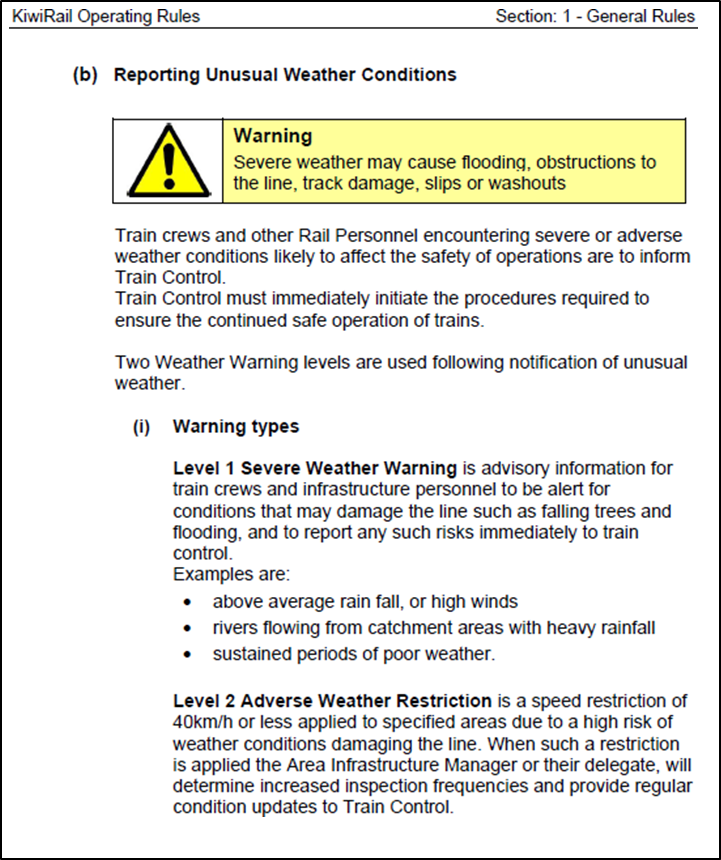
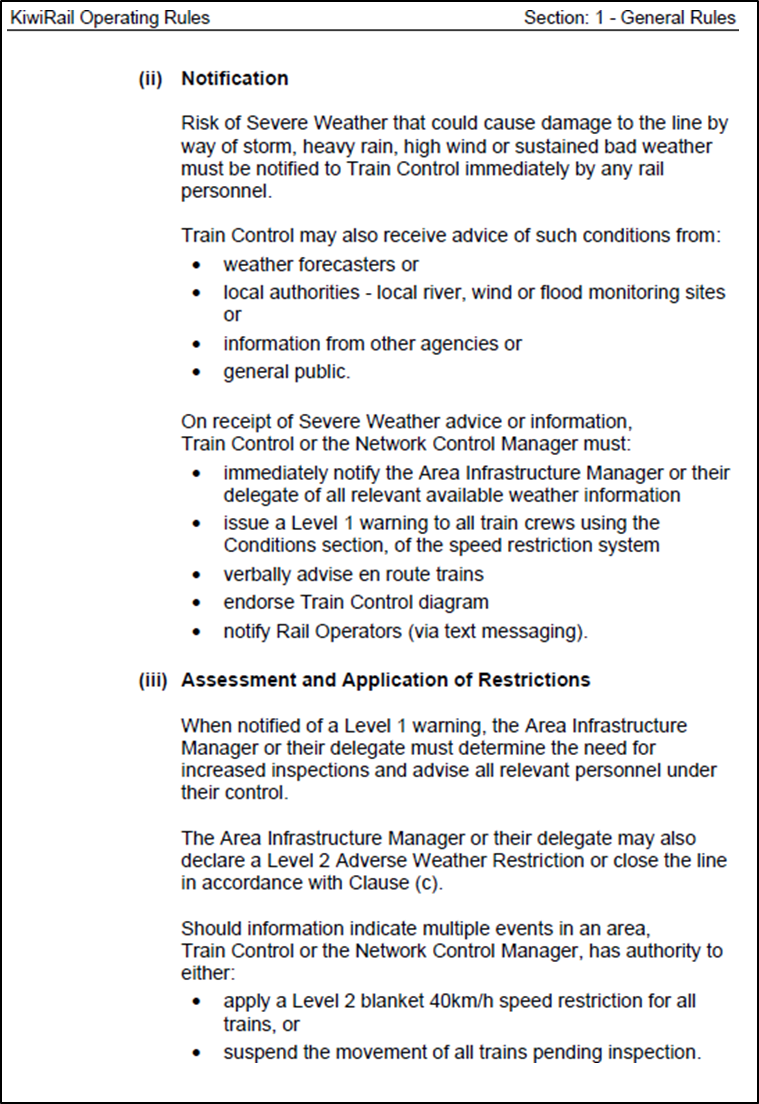
Appendix 3. Rail resilience map risk assessment tool and consequence impact

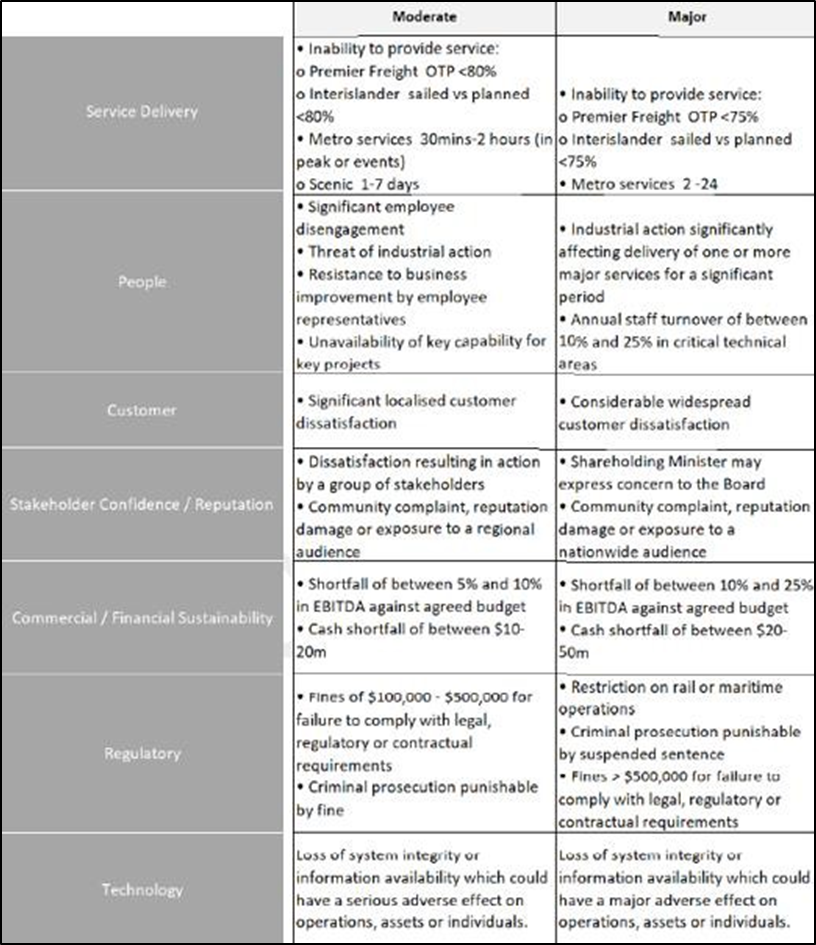
Related Recommendations
On 24 April 2024 the Commission recommended that KiwiRail satisfy itself that all waterways within the rail corridor, including those owned by third parties, have effective and up-to-date maintenance programmes to ensure that the waterways can function as designed.
On 24 April 2024 the Commission recommended that KiwiRail place greater emphasis on training rail personnel in reporting unusual weather conditions (in accordance with KiwiRail’s Operating Rules, Section 1 – General Rules, rule 6(b), to ensure they retain currency.
On 24 April 2024 the Commission recommended that KiwiRail review its adverse weather response system and processes to ensure they are effective in maintaining a safe rail network.
